The Orchid Guide
Orchids are among the most elegant and diverse groups of flowering plants in the world. With their exotic blooms, long-lasting flowers, and architectural foliage, orchids add refined beauty to indoor plant collections and greenhouse displays. While many people believe orchids are difficult to care for, most types sold as houseplants are surprisingly adaptable and rewarding with the right routine.
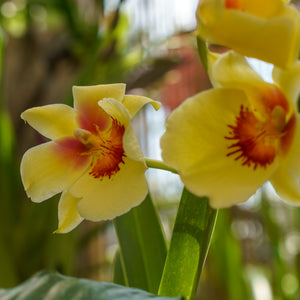
About
Orchids belong to the Orchidaceae family, one of the largest plant families with over 25,000 species and more than 100,000 hybrids. Although they are naturally found on every continent except Antarctica, most houseplant orchids originate from tropical or subtropical regions.
Popular types for indoor growing include:
- Phalaenopsis (moth orchid): The most common houseplant orchid, known for its large, arching sprays of blooms in colors from white and pink to purple and variegated forms like Phalaenopsis amabilis 'Variegata' or mini types like Phalaenopsis piccola.
- Dendrobium: Offers cane-like stems and a prolific bloom display, with flowers typically emerging from between leaves.
- Oncidium: Often called “dancing lady” orchids, with delicate, frilly flowers and light fragrance.
- Miltonia (pansy orchid): Named for their flat, colorful blooms that resemble garden pansies.
- Paphiopedilum (lady slipper orchid): Known for its pouch-like bloom and lush, often mottled foliage.
- Ludisia discolor: Also called jewel orchid, valued more for its velvety, dark leaves with silver veining than its flowers.
Orchids may be epiphytic (growing on trees in nature) or terrestrial (growing in soil), which affects their care needs and potting media.
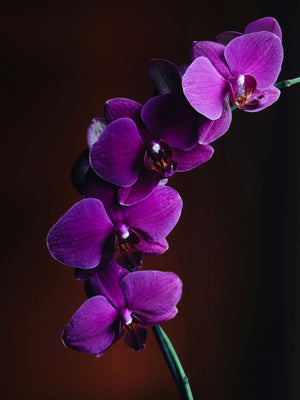
PLANTING
Orchids aren’t planted in traditional soil. Most prefer special orchid mixes that mimic the airy, well-draining conditions of their native environments:
- USDA Hardiness Zones: Most orchids are grown indoors year-round unless you live in Zone 10–12.
- Potting Media: Use a chunky orchid mix made of bark, perlite, charcoal, or sphagnum moss. Terrestrial orchids like Paphiopedilum may prefer finer media.
- Containers: Orchid pots often have slits or holes for improved airflow. Clear pots are useful for monitoring root health.
- Light: Provide bright, indirect light. East-facing windows are ideal. Too much sun can scorch leaves; too little can prevent blooming.
- Humidity: Most orchids thrive in 50–70% humidity. Grouping plants or using a humidifier can help.
Repot orchids every 1–2 years or when roots outgrow the pot or the media begins to break down.
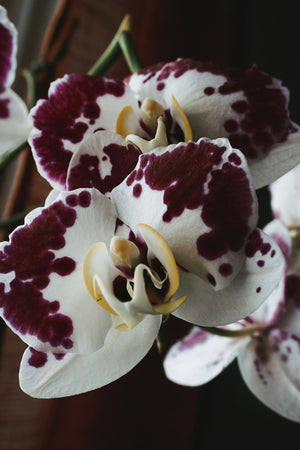
CARE
With a few consistent practices, orchids can bloom repeatedly and stay healthy for many years:
- Watering: Water once a week or when the media is dry 1–2 inches down. Let water run through the pot; do not allow orchids to sit in standing water.
- Feeding: Use a balanced orchid fertilizer (20-20-20) every 2–4 weeks during active growth. Dilute to half strength.
- Airflow: Good air circulation helps prevent rot and disease. Avoid stagnant conditions.
- Pruning: Trim off spent flower spikes once the blooms fall. For Phalaenopsis, you can cut just above a node to encourage reblooming.
- Cleaning: Wipe dust from leaves regularly. Avoid leaf shine products.
Different genera have slightly different routines. For example, Dendrobium may require a dry rest period to encourage flowering.
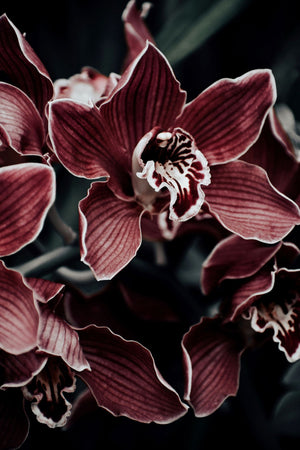
HOW TO USE
Orchids make exceptional statement plants in indoor decor and offer a variety of display possibilities:
- Focal Point: Place a blooming Phalaenopsis on a table or mantle for instant elegance.
- Group Display: Cluster multiple orchids—like Miltonia, Oncidium, and Paphiopedilum—for a lush indoor jungle.
- Bathroom Plants: High humidity bathrooms can mimic natural orchid habitats. Just ensure there’s filtered light.
- Terrariums or Glass Vessels: Smaller orchids like Ludisia discolor can thrive in enclosed displays with maintained humidity.
Pair orchids with leafy plants like calatheas or ferns to contrast their clean lines and intricate blooms.
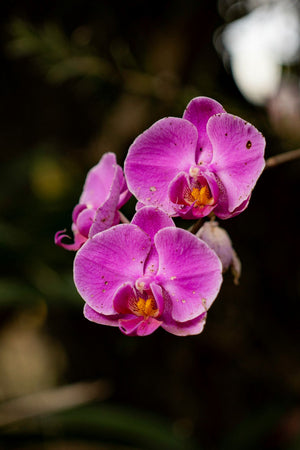
COMMON QUESTIONS
- Are orchids poisonous to cats? Most orchids, including Phalaenopsis, are not toxic to cats. However, it’s best to discourage nibbling.
- Are orchids poisonous to dogs? No, orchids are generally considered safe for dogs.
- How to care for orchids? Provide bright, indirect light, water when dry, use a chunky orchid mix, and fertilize monthly during the growing season.
- How to repot an orchid? Gently remove the plant, trim dead roots, place in fresh orchid mix, and stabilize it in a slightly larger pot.
- How to water orchids? Water deeply but infrequently, allowing water to drain fully. Never let roots sit in water.
- How long do orchids live? With proper care, many orchids live 10–20 years or more. Some may bloom multiple times each year.
- Are orchids edible? While most ornamental orchids are not edible, some like Vanilla planifolia are used in food production. Do not consume flowers unless you are certain they are food-safe.
Conclusion
Orchids are a diverse and striking group of plants that can elevate any indoor garden with their exotic flair. Whether you're captivated by the classic Phalaenopsis, the charm of Oncidium, or the lush foliage of Ludisia discolor, there's an orchid for every taste and space. With a little understanding of their unique needs, these long-lived plants can reward you with ongoing beauty and satisfaction.
The Orchid Collection
Sold Out
Sold Out
Sold Out
Sold Out
Sold Out






